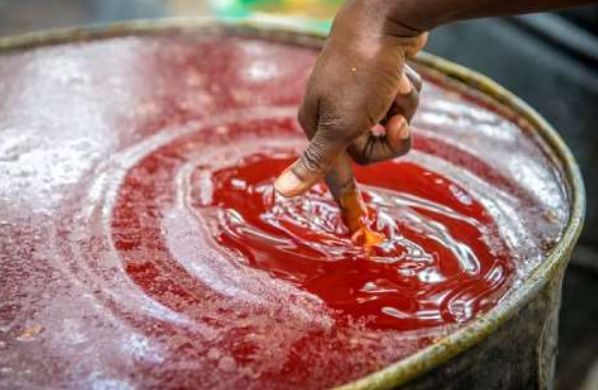Red Gold: The Rise and Fall of West Africa’s Palm Oil Empire

For thousands of years, the oil palm, native to West Africa, has maintained an intimate relationship with man. The very rapid expansion of palm groves throughout West and Central Africa after a period of drought dating back approximately 2,500 years has encouraged human migration and the development of agriculture; in turn, men promoted the spread of oil palms by dispersing their seeds and practicing slash-and-burn cultivation.
Archaeological evidence shows that palm fruits and their oil were already an integral part of the diet of West Africans 5,000 years ago.
With the exception of the “royal” oil palm plantations, established in the 18th century for the production of palm wine in the Kingdom of Dahomey, all West African oil palms grew in wild or semi-wild groves. -wild.
Women and children picked up fruit that had fallen on the ground, while men collected bunches of fruit by climbing to the tops of palm trees. These fruits were then processed into palm oil by the women, in a long and labor-intensive process that involved repeatedly boiling and straining the fresh fruits with water. Similar methods are still widely used throughout West Africa. Women prepare palm oil in Côte d’Ivoire. SIA KAMBOU/AFP via Getty Images
While pure red palm oil was extracted from the fleshy outer mesocarp of the palm fruit, women, often aided by children, also cracked the seeds of this tree to make brown and clear palm kernel oil.
Palm oil was, and remains, a key ingredient in West African cuisine, such as the simple dish of boiled yam, palm oil and rock salt (Kanwa), and Banga soup.
Throughout West Africa, palm oil was used for soap making; today, Dudu-Osun Yoruba Black Soap is a registered trademark in Nigeria. In the Kingdom of Benin, palm oil was used for lampposts and as a building material for the walls of the king’s palace. It has also found its way into hundreds of different rituals and medicinal products, including as a skin ointment and as a common antidote to poisons. In addition, sap from oil palms was collected for the production of palm wine, and palm fronds provided material for thatched roofs and brooms.
The boom of the early 19th century
Palm oil has been known in Europe since the 15th century. It was the slave traders of Liverpool and Bristol who, at the beginning of the 19th century, began to import them on a larger scale. They knew of its many uses in West Africa and already bought it regularly to feed the slaves deported to the Americas.
With the abolition of the slave trade to the Americas in 1807, British West African traders turned to European markets and natural resources as raw materials, especially palm oil. At that time, the main foods, rich in fats and lipids in Europe were of animal origin – such as lard or fish oil – products for which it could be difficult to ensure a regular supply. Thus, the palm oil market was a ready-made outlet. Ethnic Igbo men from the Oil Rivers region of present-day Nigeria bring calabashes full of palm oil to sell to a European buyer, circa 1900.
This oil was used as an industrial lubricant, in the production of tinplate, in street lighting and as a semi-solid fat for the manufacture of candles and soap. In the 1820s, advances in chemistry facilitated the shift to large-scale industrial soap production.
Ever-increasing quantities of palm oil – rising from 157 metric tonnes a year in the late 1790s to 32,480 tonnes in the early 1850s – were brought into the UK by small West African traders.
This trade was not for the faint hearted. Once a year traders would spend up to six weeks sailing on small schooners to one of the many trading stations on the West African coast. There were several dozen trading stations in the Oil Rivers region of what is now the Niger Delta, the center of the palm oil trade in West Africa.
European traders lived and traded entirely on derelict sailing ships. This was partly to try to avoid deadly diseases, such as malaria and yellow fever, but also because local authorities prevented them from building on dry land. Internal trade was tightly controlled by local brokers and village chiefs.
European traders gave these brokers European goods, such as cooking utensils, salt, and cloth. Then they waited aboard their ships for the brokers to return, which could sometimes take months. Many African brokers were themselves former slavers. The slave trade in the Niger Delta did not immediately end with abolition, but continued alongside the palm trade until the 1840s. European palm brokers and traders continued to use the same network and system developed for the slave trade.
In the meantime, the coopers of European traders assembled large casks to hold the palm oil.
There were mainly the existing wild and semi-wild groves in West Africa to satisfy European demand. In the hinterland of the Oil Rivers and in many other areas, one could find an abundance of wild oil palms to harvest. A few other palm trees were planted. The Krobos in southeastern Ghana, where few oil palms grew naturally, had begun to practice systematic cultivation to meet European demand.
In Dahomey too, new plantations have been established. Some parts of southeastern Nigeria have become so focused on palm oil production that they have become totally dependent on imports of yams from the north. However, there has not been a radical and large-scale transformation in land management, ownership or ecology.
The rise of palm oil brokers
West African producers have successfully responded to increased demand for European palm oil by modifying and expanding existing small-scale production methods.
The young men were in charge of harvesting the bunches of fresh fruit – dangerous work. For the treatment of palm oil, another method, much less labor intensive, has been developed. It was necessary to wait for the fresh fruits to ferment, before being trampled in large pits dug in the ground, or sometimes in old canoes. The oil thus obtained was much dirtier and indigestible; it was also cheaper, but this new technique made it possible to produce it on a larger scale than before.
Transporting palm oil was a lot of work: you had to carry calabashes filled with oil along forest roads to the nearest river and work on canoes. This provided a source of cash income for the young men, but it was usually the older and already wealthier men, and especially the chiefs, who benefited most from the “red gold”, thanks to the labor of their wives and slaves and control of trade.
Wealth and power could be acquired through brokerage, and local power structures were deeply tied to the palm oil trade. A particularly powerful broker at this time was William Dappa Pepple, the amanyanabo (king) of Bonny (in present-day south-eastern Nigeria) from 1837 to 1854.
Colonial takeover
At the end of the 19th century, chemists discovered that hydrogenation could be used to transform vegetable oils into margarine. This played an increasingly important role in providing fat in the diets of Europe’s growing urban working class. As the volume of palm oil imports from West Africa to the United Kingdom stabilized between the 1850s and 1890s, the large-scale production of this new edible product revived the demand for palm oil at the beginning of the 20th century.
Between 1854 and 1874, France and Britain had already begun to create official European colonies in Senegal, Lagos and La Côte-de-l’Or (Gold Coast). British West Africa eventually incorporated Sierra Leone, Gambia, the Gold Coast and Nigeria (along with British Cameroons).
In the 1930s, British West Africa exported around 500,000 tons of palm products annually. These products continued to play a major role in the rural economies of West Africa, but they gradually escaped local control under the colonial administration; the potential wealth and power that palm oil had brought to the local population was gone.
Moreover, as the colonial powers continued to expand their influence elsewhere in the tropics, a game-changing development was slowly coming: the rise of palm oil plantations.
Within decades, swaths of Southeast Asian forests were cleared, creating a fast track to industrial-scale monoculture plantations, ending West Africa’s position as a as a global hub for palm oil production.
A version of this article originally appeared on China Dialogue .
Pauline von Hellermann does not work for, consult, own shares in or receive funding from any company or organisation that would benefit from this article, and has disclosed no relevant affiliations beyond their academic appointment.
By Pauline von Hellermann, Senior Lecturer, Anthropology, University of London





